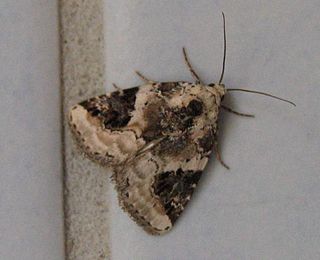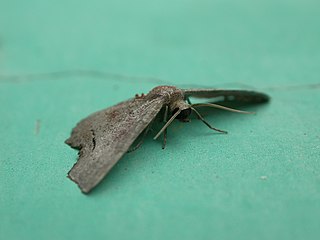Anigraeopsis is a monotypic moth genus of the family Euteliidae. Its only species, Anigraeopsis subalbiplaga, is found on New Guinea. Both the genus and species were first described by Warren in 1914.
Aplotelia is a genus of moths of the family Euteliidae. The genus was described by Warren in 1914.
Coeriana is a genus of moths of the family Erebidae. The genus was erected by Francis Walker in 1858.
Vescisa is a genus of moths in the family Noctuidae. The genus was erected by Francis Walker in 1864.
Diplothecta is a monotypic moth genus of the family Noctuidae. Its only species, Diplothecta loxomita, occurs in Queensland, Australia. Both the genus and species were first described by Alfred Jefferis Turner, the genus in 1920 and the species 12 years earlier in 1908.
Ecnomia is a monotypic moth genus of the family Noctuidae. Its only species, Ecnomia hesychima, is found in Australia in Western Australia, the Northern Territory and Queensland. Both the genus and species were first described by Turner in 1936.
Haplopseustis is a monotypic moth genus of the family Noctuidae. Its only species, Haplopseustis erythrias, is found in Australia where it has been found in the Northern Territory and Queensland. Both the genus and species were first described by Edward Meyrick in 1902.
Heterorta is a monotypic moth genus of the family Noctuidae described by Warren in 1913. Its only species, Heterorta plutonis, was first described by Thomas Pennington Lucas in 1894. The species is known from Australia where it has been found in Queensland, New South Wales and Victoria.
Microedma is a monotypic moth genus of the family Noctuidae. Its only species, Microedma extorris, is found in New Guinea and Australia. Both the genus and species were first described by Warren in 1913.
Orthoruza is a monotypic moth genus of the family Noctuidae. Its only species, Orthoruza niveipuncta, is found in New Guinea. Both the genus and species were first described by Warren in 1913.
Oxytrita is a monotypic moth genus of the family Noctuidae described by Warren in 1913. Its only species, Oxytrita bipars, was first described by George Hampson in 1907. It is found in Khasis and Kanara, both in what was then British India.

Penicillaria is a genus of moths of the family Euteliidae. The genus was erected by Achille Guenée in 1852.
Pseudephyra is a genus of moths of the family Noctuidae. Is only species, Pseudephyra straminea, is found in Australia. Both the genus and species were first described by Arthur Gardiner Butler in 1886.

Pseudeustrotia is a genus of moths of the family Noctuidae. The genus was erected by William Warren in 1913.
Stenocryptis is a monotypic moth genus of the family Noctuidae. Its only species, Stenocryptis punctata, is found in the Khasi Hills of north-eastern India. Both the genus and species were first described by Warren in 1913.
Lacistophanes is a monotypic moth genus in the family Geometridae. Its only species, Lacistophanes hackeri, is found in the Australian state of Queensland. Both the genus and species were first described by Turner in 1947.

Xenozancla is a monotypic moth genus in the family Geometridae. Its only species, Xenozancla versicolor, is found in northern India. Both the genus and species were first described by William Warren in 1893.

Pasma tasmanicus, the two spotted grass skipper, is the only species in the monotypic butterfly genus Pasma of the family Hesperiidae. The genus was erected by Gustavus Athol Waterhouse in 1932. The species was first described by William Henry Miskin in 1889. It is found in the Australian states of New South Wales, South Australia, Tasmania and Victoria.
Miaromima is a genus of moths of the family Nolidae. The genus was erected by Edward Meyrick in 1889.

Epipsestis is a genus of moths belonging to the subfamily Thyatirinae of the Drepanidae. It was erected by Shōnen Matsumura in 1921.




